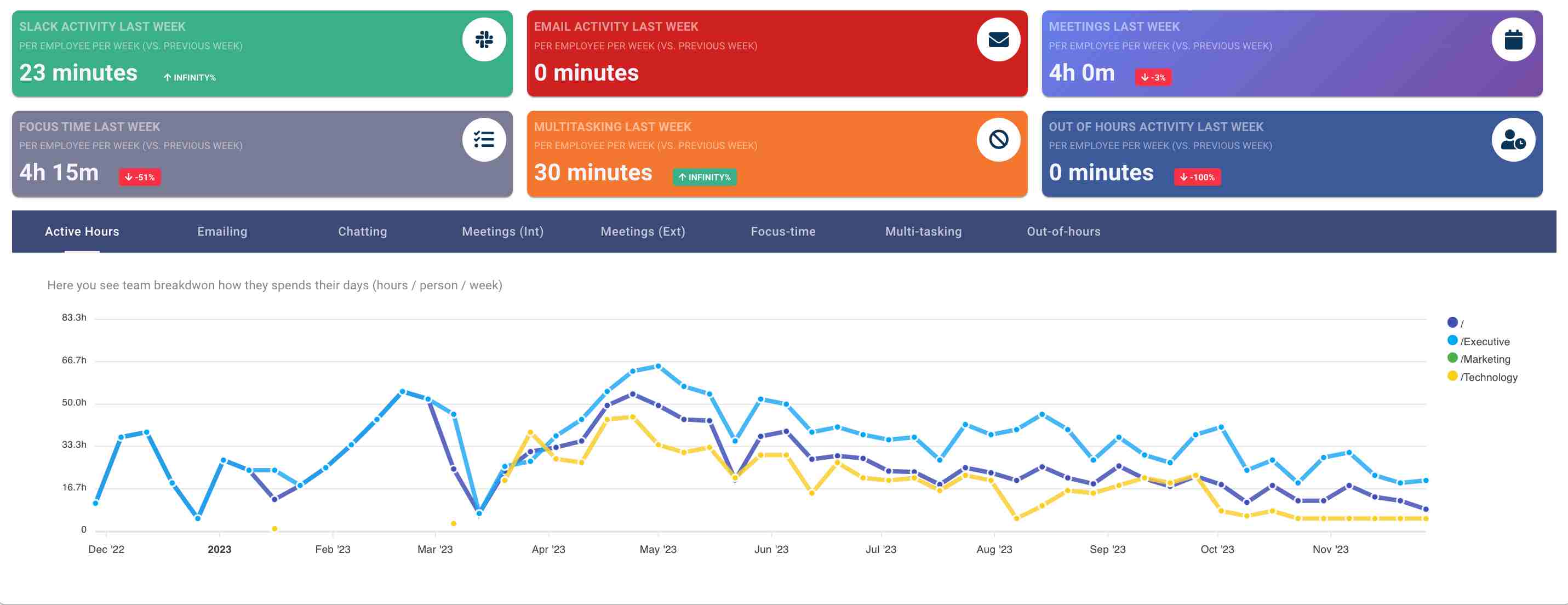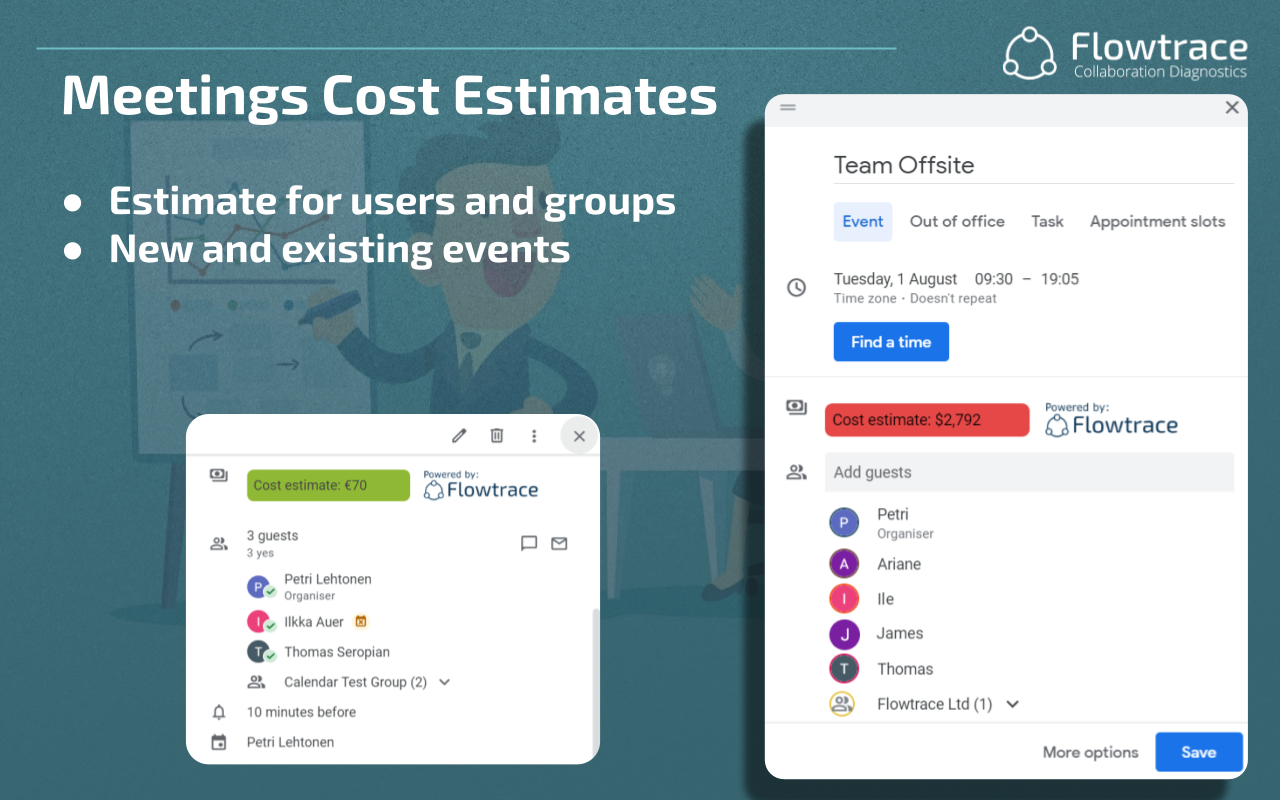Implementing Data-Driven Meeting Cultures
Transform your organization with data-driven meeting cultures. Learn how to optimize meetings, increase productivity, and drive better business...
Transform company meetings for enhanced productivity and engagement. Learn how to optimize meeting culture, reduce overload, and drive success through effective leadership and data-driven insights.
Effective meetings are essential in driving organizational success and result in decision-making, strategic planning, and team collaboration. When meetings are well-structured and purposeful, they can significantly enhance productivity, foster innovation, and ensure alignment with organizational goals. However, often teams are experiencing symptoms of meeting overload and leadership is unaware that they need to transform company meetings.
Leadership plays a crucial role in transforming the meeting culture within an organization. Leaders set the tone for how meetings are conducted, ensuring they are purposeful, engaging, and aligned with strategic objectives. By modeling best practices and leveraging data-driven insights, leaders can optimize meeting structures and foster a culture of continuous improvement.
Meeting culture refers to the collective behaviors, norms, and practices that characterize how meetings are conducted within an organization. It includes various aspects such as the frequency and duration of meetings, the structure and format of agendas, the level of participant engagement, and the overall atmosphere during meetings. A healthy meeting culture ensures that meetings are well-organized, purposeful, and conducive to productive discussions and decision-making.
Key components of meeting culture include:
A positive meeting culture can lead to significant improvements in team productivity and engagement. When meetings are well-structured and effectively managed, they become valuable opportunities for collaboration, problem-solving, and strategic planning. However, poorly managed meetings can drain time and energy, leading to frustration and disengagement among team members.
Increased Productivity: According to the latest meeting statistics, companies with effective meeting practices experienced a 28% increase in productivity. Clear agendas, defined objectives, and efficient time management ensure that meetings are productive and focused.

Enhanced Engagement: When team members feel that their time is respected and their contributions are valued, they are more likely to be engaged and motivated. Engaged employees are more likely to participate actively in meetings, leading to more dynamic and fruitful discussions. According to a Gallup report, organizations with high employee engagement see a 21% increase in profitability and a 17% increase in productivity.
Better Decision-Making: Positive meeting cultures promote open communication and inclusive participation, which are critical for effective decision-making. Diverse perspectives lead to more comprehensive discussions and well-rounded decisions.
Reduced Burnout: Limiting the number of unnecessary meetings and ensuring that necessary meetings are efficient helps prevent employee burnout. This is particularly important in today’s work environment, where remote and hybrid work arrangements can lead to an increase in meeting frequency.
Meeting overload occurs when employees are bogged down by frequent, unproductive meetings that detract from their core responsibilities. Symptoms of meeting overload include:

A study by Harvard Business Review highlights that unproductive meetings are a significant issue, with 71% of senior managers feeling that meetings are unproductive and inefficient.
Excessive meetings can lead to employee burnout, which negatively affects morale and productivity. Key impacts include:

Inefficient meetings not only affect employee well-being but also have significant financial implications.
Data-driven decision-making is crucial in optimizing meeting management. By leveraging data analytics, organizations can gain actionable insights into their meeting practices, identifying areas for improvement and making informed adjustments. This approach helps in enhancing meeting efficiency, reducing unnecessary meetings, and improving overall productivity.
Meeting Frequency and Duration
Participation and Engagement Levels
Meeting Costs

Productivity (Deep Work)
Decision-Making Efficiency
Follow-Up and Action Item Completion
Automated Tools: Utilize meeting analytics tools like Flowtrace to automatically collect data on meeting frequency, duration, participation, and engagement. These tools integrate with calendars and communication platforms to provide comprehensive insights.
Surveys and Feedback: Conduct regular surveys to gather feedback from participants about meeting effectiveness and engagement. Use this qualitative data to complement quantitative metrics and gain a deeper understanding of meeting dynamics.

Meeting Records and Transcripts: Analyze meeting records and transcripts to assess the quality of discussions and decisions. This can help identify common issues such as off-topic discussions or unclear decision-making processes.
Dashboards and Reports: Implement dashboards that visualize key meeting metrics in real-time. Regularly review these reports to track progress, identify trends, and make data-driven adjustments to meeting practices.
Conducting a Meeting Audit to Identify Unnecessary Meetings
To reduce meeting overload, start with a thorough audit of your current meeting schedule. This involves:
Setting Clear Objectives and Agendas for Every Meeting
Having clear objectives and structured agendas can significantly enhance meeting efficiency:
Encouraging Asynchronous Communication to Replace Some Meetings
Shifting some communication to asynchronous methods can free up time and reduce the need for frequent meetings:
Techniques to Ensure Necessary and Active Participation
Role Assignment: Assign specific roles to participants such as facilitator, note-taker, and timekeeper. This ensures that everyone has a responsibility and remains engaged throughout the meeting. Rotate roles regularly to provide different team members with opportunities to contribute and lead.
Use Meeting Policies: Set clear expectations for participation at the beginning of each meeting. Let participants know that their input is valuable and expected. Encourage participants to prepare questions or comments on agenda items beforehand. Utilizing meeting policies is effective here.
Interactive Agendas: Design meeting agendas that include interactive elements such as brainstorming sessions, round-robin discussions, or breakout groups. Allocate time for each participant to share their insights on specific topics.
Promoting Inclusivity and Diverse Viewpoints in Meetings
Encourage Diverse Participation: Actively invite input from quieter or less vocal team members to ensure a diversity of perspectives. Use techniques like round-robin discussions where each participant has a set time to speak, ensuring everyone’s voice is heard.
Acknowledge Contributions: Recognize and appreciate contributions from all participants to encourage further engagement. Summarize and reference participant contributions throughout the meeting to show that their input is valued and considered.
Utilizing Interactive Tools to Engage Participants
Polling and Surveys: Use real-time polling and surveys to gauge participant opinions and gather instant feedback on discussion topics. Interactive tools like Slido or Mentimeter can help keep participants engaged and involved.
Live Q&A Sessions: Integrate live Q&A sessions where participants can submit questions and vote on the most relevant ones. Tools like Zoom’s Q&A feature or Google Meet’s question module can facilitate this interaction.
Leading by Example: Leaders should demonstrate effective meeting practices by being punctual, prepared, and fully engaged. This sets the standard for the rest of the team to follow.
Show respect for everyone’s time by keeping meetings focused and adhering to the agenda. Start and end meetings on time to build a culture of efficiency.
Structured Agendas: Leaders should develop and circulate detailed agendas before each meeting, clearly outlining the objectives and topics to be covered. Encourage team members to review the agenda in advance and come prepared with relevant questions and contributions.
Active Facilitation: Actively facilitate meetings to ensure that discussions remain on track and that all voices are heard. This includes managing time effectively and preventing any one person from dominating the conversation.
Use techniques such as summarizing key points and confirming action items at the end of the meeting to ensure clarity and follow-through.
Communicating the Benefits of Optimized Meetings to the Team
Transparency and Communication: Clearly communicate the reasons for optimizing meeting practices and the expected benefits, such as increased productivity, better decision-making, and reduced stress. Share success stories and positive outcomes from improved meeting practices to illustrate their impact.
Training and Support: Provide training and resources to help team members understand and adopt best practices for meeting management. This can include workshops, guidelines, and one-on-one coaching. Offer continuous support and be open to feedback to address any challenges or resistance to change.
Incentivizing Participation: Recognize and reward team members who consistently contribute to making meetings more effective. This can be through formal recognition programs or informal praise. Encourage a sense of ownership by involving team members in the process of refining meeting practices.
Fostering a Culture of Accountability and Continuous Improvement
Setting Clear Expectations: Establish clear expectations for meeting conduct, including punctuality, participation, and follow-through on action items. Make these expectations a part of the team’s culture. Hold regular reviews to assess meeting effectiveness and address any issues promptly.
Accountability Mechanisms: Implement mechanisms to ensure accountability, such as tracking attendance, participation, and the completion of action items. Use tools and software to streamline this process. Encourage self-assessment and peer feedback to promote individual accountability and continuous improvement.
Promoting Continuous Improvement: Foster an environment where continuous improvement is valued. Regularly solicit feedback on meeting practices and be willing to make adjustments based on this input. Use data and analytics to track progress and identify areas for further improvement. Encourage the team to view meetings as dynamic and evolving processes rather than static events.
Flowtrace offers comprehensive analytics designed to optimize meeting culture through detailed analytics and actionable insights, including:
Meeting Metrics and Analytics:

Collaboration Insights:
Action Item Tracking:
Integration with Existing Tools:

Data-Driven Insights: Analyze meeting data with actionable insights. By highlighting trends and patterns, it helps organizations identify inefficiencies and areas for improvement. For example, if meetings are frequently running over time, you can pinpoint which agenda items tend to cause delays.

Real-Time Dashboards: View real-time dashboards that visualize key metrics, allowing leaders to quickly assess meeting performance. These dashboards can be customized to focus on the most relevant data for the organization, such as engagement levels, meeting costs, and decision-making efficiency.
Meeting Cost Analysis: Calculates the financial impact of meetings based on participant salaries and meeting durations. This helps organizations understand the cost implications of their meeting practices and identify opportunities for cost savings.

Addressing meeting inefficiencies is critical for any organization aiming to enhance productivity, employee engagement, and overall operational effectiveness. Inefficient meetings not only waste valuable time but also lead to increased costs, employee burnout, and decreased morale. By optimizing meeting practices, organizations can create a more focused, collaborative, and efficient work environment.
By integrating Flowtrace into their workflows, leaders can gain comprehensive insights into meeting dynamics, track key metrics, and make informed decisions to optimize meeting practices. Flowtrace’s capabilities in meeting analytics, collaboration insights, and action item tracking provide a robust framework for continuous improvement.
Transform your organization with data-driven meeting cultures. Learn how to optimize meetings, increase productivity, and drive better business...
Optimize your meetings with a data-driven approach. Learn how to analyze key metrics to improve efficiency, reduce costs, and enhance collaboration.
Discover actionable strategies to reduce meeting costs and boost organizational efficiency through careful planning and data-driven decisions.